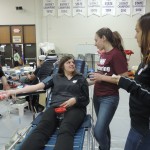NHS hosts annual blood drive

On Wednesday, April 6, students and staff members volunteered to donate their blood at the annual blood drive sponsored by the Parkway North National Honor Society.
According to The American Red Cross, while an estimated 38% of the U.S. population is eligible to donate, less than 10% actually do each year. Donating blood is voluntary and one donation can help save up to three people.
Senior Stephanie Kim, one of the students who donated blood on Wednesday, said, “[I donate blood] because it saves lives…I think that if you’re healthy it’s your duty to help other people [who aren’t].”
Even though donating blood is encouraged, not everyone is eligible to donate blood. Certain criteria must be meet in order for people to donate: be in good general health, weight at least 110 lbs., and be at least 17-years-old (or 16-years-old with parent permission).
Some people who meet the the criteria may not donate because they are afraid of needles. These people might want to talk to a professional or to someone who has done it before.
“[It’s important to remember that] most of it is just nerves. It’s a good thing to do for yourself. It’s good for your health, and it’s good to get involved in something on a volunteer basis,” said Phlebotomist Sydney Wilson, who worked the blood drive. “The incentive is to provide for the community, because you’re not getting paid to do it — it’s [a good feeling] to do something good for your community.”
After a person is registered to give blood, their temperature, blood pressure, pulse and hemoglobin are checked to ensure their safety. If it is determined that it is safe for the person to donate blood, they are sent to a phlebotomist, who extracts the blood and ensures that the process goes well. Once the blood is collected, it is sent to a lab where it is tested to determine the blood type and to make certain that there are no diseases. Then, the blood is delivered to hospitals and other institutions that need it.
“It’s important for the community because we are the main provider for a lot of hospitals…It’s important for people to keep donating so that we are not short on blood supply because some people may need a lot of blood transfusions,” said Wilson.
Photo by Ryan Lutker, Sports Editor
